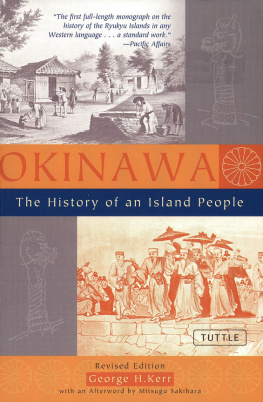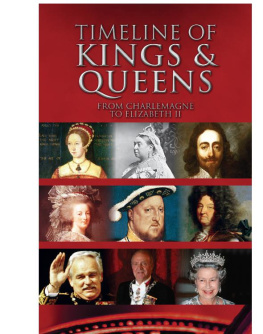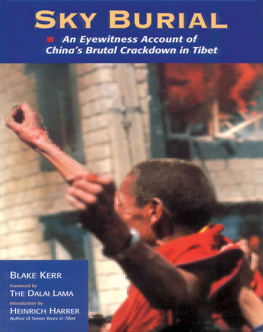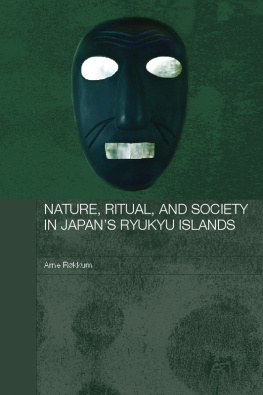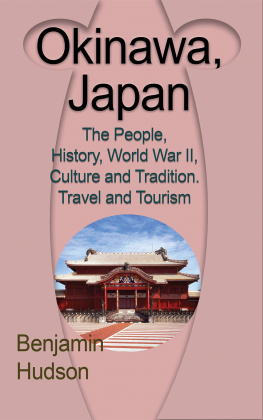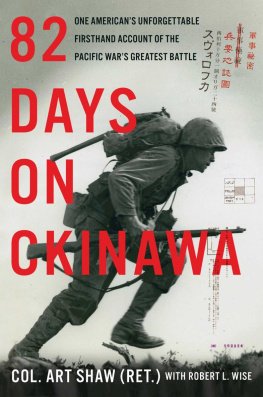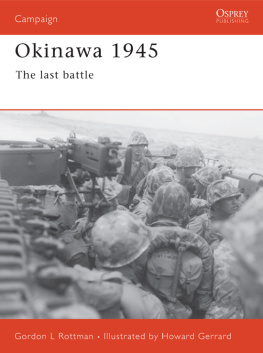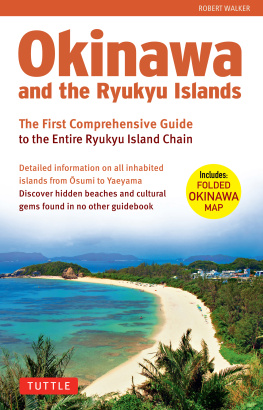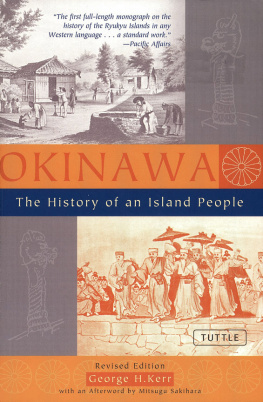ACKNOWLEDGMENTS
In 1951 the Pacific Science Board of the National Research Council inaugurated a series of scientific investigations of the Ryukyu Islands. These are known as the siri series, authorized by the Department of the Army and subsidized by funds appropriated for the relief and rehabilitation of occupied areas, the so-called garioa funds. In 1952 the Civil Administrator for the Ryukyu Islands (Brigadier General James M. Lewis) asked the Board for a supplementary study concerning the history of the islands. This, he believed, might throw light upon many problems which the military administration encountered from day to day.
Acting upon suggestions made by Dr. Harold J. Coolidge and Dr. George P. Murdock, of the Pacific Science Board, General Lewis asked me to prepare a historical summary with a view to having it translated into Japanese for distribution in Okinawa. He felt that Okinawan youth, uprooted by war and cut off from Japan, knew very little of its past history and vitually nothing of the circumstances which had drawn the United States to the western Pacific frontier and into Okinawa for a second time within a hundred years. It was apparent, too, that civilian employees of the occupying military organization needed to gain some historical perspective for their tasks.
I undertook a reconnaissance of the historical topography, visiting Okinawa, Iriomote, Ishigaki, Miyako, and Iheya-Izena islands, checking sites of special interest, and listening to local folklore and traditions. I am indebted to Mr. Yonaguni Zenzo for lengthy chronological tables and historical notes to carry into the field. These have since been published by him in Japanese. Messrs. Kakazu Sunao, Nakachi Tetsuo, Kamemura Toshio, Kabira Chosei, and many others proved most helpful guides on these field trips. At Naha and Shuri I was given invaluable assistance by the late Professor Shimabukuro Zempatsu, Mr. Shiroma Chokyo, Mr. Minamoto Takeo, Mr. Kabira Choshin, and the late Mr. Hamada Zenkichi, Curator of the Shuri Museum.
At Tokyo, meanwhile, I inaugurated a search throughout Japan for materials concerning the Ryukyus. An informal committee of prominent Okinawans advised me from time to time on bibliography and on disputed points in history. Among them were Professors Higaonna Kanjun, Nakahara Zenchu, and Takazato Ryokun, and Mr. Yoshida Shien. The principal burdens of research fell on Mr. Higa Shuncho and his most faithful aides, Kuniyoshi Masakane and Kudeken Kenji. Mr. Kudeken continued to serve as research assistant after coming to the United States as a garioa scholar.
Many points in Okinawan history are in dispute and many may never be settled conclusively, for the prime resourcesthe ancient archives of the old kingdomwere destroyed in 1945. Students must now rely upon materials surviving in Japan and upon the works of Japanese scholars who had access to original documents before 1945.
I assume full responsibility for interpretations of fact which may be at variance with traditional views, or may be subjects of irreconcilable dispute among the scholars, and shall be happy if this survey by a foreigner provokes interest among Okinawan students and elicits new appraisals of Okinawan history.
The original study (the Pacific Science Board mimeographed edition) was entitled Ryukyu: Kingdom and Province before 1945 . It was submitted to General Lewis shortly before his death in 1953. In 1956 a Japanese translation appeared; this was entitled Ryukyu Rekishi (Ryukyuan History.)
In fairness to my associates in Japan and Okinawa, and to the Pacific Science Board, it should be noted that they may be absolved of all responsibility for the Japanese-language version of the original siri report. It was prepared without consultation with them (or with the author) after the original text had passed through the hands of the Director of Civil Information and Education then holding office at Naha, and had been assigned as a project to a committee of eight translators, each undertaking a portion of the work.
On February 10, 1956, the author obtained clearance to publish an English-language edition based on the siri report of 1953. For this I wish to thank Colonel Norman D. King and Mr. Joseph E. Harbison, of the Office of Civil Affairs and Military Government, Department of the Army, Washington.
The original text has been enlarged and recast to bring forward the story of European and American interest in the Ryukyu Islands in the 19th century, and to note (by way of introduction) the manner in which the United States government established a legal basis for the present occupation. These additional materials were developed largely in response to questions raised in 1953-54 at the University of California (Berkeley) by students examining the history of American activity on the western Pacific frontierthe Ryukyus and Formosa in an attempt to discover the sources of information upon which policymakers at Washington based far-reaching decisions to hold Okinawa after Japan's surrender in 1945. The general bibliography of Western-language references to the Ryukyus available to them has been appended to this summary history.
Neither the Army nor the Pacific Science Board is to be held responsible for the present work.
I am indebted to the Pacific Science Board and to its talented Secretary, Lenore Smith, for support in carrying through the original siri project, and to Mary Hawkins Johnson, my secretary at the Hoover Institute, for tireless assistance in preparing the present text. I am likewise under obligation to Dr. Mitsuna Nagamine, Director of Library Research at Tokyo University, and to the librarians at the University of California (Berkeley) and the University of Hawaii for friendly, patient, and painstaking cooperation. So, too, my thanks to Professors E. Wiswell, H. Ikeda, and Y. Uyehara, and to K.M. Thompson for aid in translation and proofreading.
For permission to quote from published materials I am indebted to Professor William G. Beasley and Messrs. Luzac and Company ( Great Britain and the Opening of Japan, 1834-58); Professor Charles Boxer and the Hakluyt Society of London ( South China in the Sixteenth Century ...); Dr. Schuyler Cammann ( China's Dragon Robes); Dr. John K. Fairbank ("On the Ch'ing Tributary System"); Dr. Earl Swisher ("China's Management of the American Barbarians... "); and to Professors Ryusaku Tsunoda and L. Carrington Goodrich and their publisher Mr. P.D. Perkins ( Japan in the Chinese Dynastic Histories). The University of California Press has given me permission to quote from the late Professor Yoshi S. Kuno's Japanese Expansion on the Asiatic Continent . I am grateful to the authors and publishers of 19th-century materials, no longer under copyright, which I have quoted extensively here.
Plates 1-4, 6-10, and 12 are reproduced from photographs made by Mr. Sakamoto Genshichi in 1937. Figures 9, 11, 13, and 14 are reproduced through the courtesy of the East Asiatic Library, University of California (Berkeley). Portrait photographs reproduced as Plates 26, 27, and 30-35 are used with my thanks to Dr. Yukihide Kohatsu, Mrs. Takahiko Chinen, and Mr. Shuncho Higa. The aerial photograph of the old castle site was supplied through the good offices of Dr. Genshu Asato, President of Ryukyu University. Mr. Clemente Lagundimao, Jr., and the author collaborated on the maps and sketches.
The book is inscribed to my friend the late Higa Shuhei, Chief Executive of the Ryukyu Islands, 1952-56. He was unsparing in his effort to mediate between the Okinawan people and the American administration, attempting always to interpret the needs of the one to the other. His career recalls that of "Ichirazichi," who performed somewhat similar, onerous tasks at Naha more than one hundred years ago.
Honolulu, June, 1958
GEORGE H. KERR

